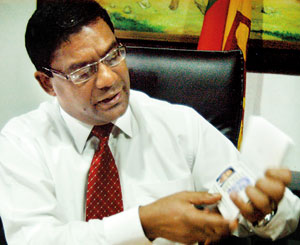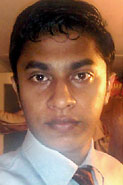Unravelling an ancient secret
The tea-break was over and the team had just reassembled at about 11 in the morning in the pit at the smaller cave of Pahiyangala, Bulathsinhala, for a research excavation.�What they did not realize was that they were about to stumble onto an ancient secret.
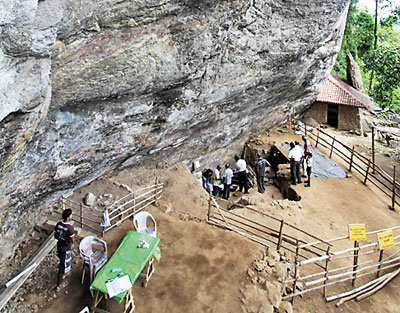
The excavation site
As they gently, very gently and meticulously, with tiny brushes swept away the earth (no big trowels or mammoties for them), while physically blowing away the dust, excitement mounted.
The excitement tinged with tension was tangible for, slowly the earth unearthed the bones of toes. Were they just random bones, like the skulls and bones found at Pahiyangala, a paradise for archaeologists on the trail of Mesolithic Man?
“No, it was not just a few bones, but a full skeleton,” recalls young W.M.C. Oshan Wedage, his voice bubbling with enthusiasm even two weeks later, but fairly and squarely giving credit to his “super crew” as well as his “extraordinary” seniors.As they tenderly unearthed the skeleton, “podi venasak thibba”, says this 30-year-old Prehistoric Excavation Research Officer of the Department of Archaeology under whom is Pahiyangala.
Located in the Kalutara District, Pahiyangala is also known as Fa Hsiengala after the Chinese monk who is said to have rested here on his way to Adam’s Peak. “We first spotted the toes, then the foot and another foot and the skeleton up to the ribs, in the east corner of the excavation pit at the smaller cave,” says Oshan.
They handled the spot carefully, for they believe that the key to the true origins of the Sri Lankan people may lie buried in the sands of time here. They did not want, to destroy “any other evidence”, such as traces of organic remains or tools the area may yield. Haste would prevent 21st century humans, that’s us, getting a glimpse of Mesolithic lives and times and clues to the identity of the human lying buried.
Oshan then gave a round of frantic calls to Archaeological Department Director-General (DG), Dr. Senarath Dissanayake; Director-Excavations, Dr. Nimal Perera and Prehistoric Specialist, Dr. Siran Deraniyagala, a former DG of Archaeology now retired but very much “after” Sri Lanka’s Ancient Man.
Oshan and crew were advised by all of them “not to hasten” as it may very well be a find of global significance.
His diligent team comprising Palitha Weerasinghe, Kamal Nanda, Karunasena, Eregama, A.V.A. de Mel, Susantha Nihal, H. Jude Perera, P.G. Gunadasa, K.P. Ruwan Pramod and K.P. Sumanadasa uncovered a part of the skeleton slightly, says Oshan.
Next came the ribs, head and teeth, the Sunday Times learns.
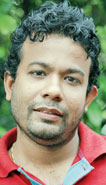
Oshan: Overwhelmed by discovery
The Prehistoric Period or Stone Age is categorized into Palaeolithic (in Greek palaeos meant “old” and lithos “stone” and this refers to the use of rough stone tools) and Mesolithic.In Sri Lanka, the Palaeolithic period is believed by Dr. Siran Deraniyagala to be from over 700,000 to 40,000 years before present (BP), the Mesolithic from 40,000 to 4,000 years BP and the Iron Age from 3,700 to historical times. The presence of the Neolithic and Bronze Age in Sri Lanka has not been established yet, says Dr. Deraniyagala who has conducted the most number of pioneering studies on the Prehistoric Period, from 1968 onwards.
It was way back in 1968 that Dr. Deraniyagala found evidence of the presence of Prehistoric remains at Pahiyangala. Having also found that both the larger and smaller caves of Pahiyangala were replete with pointers that they would have harboured settlements of the Balangoda Man, the popular name for Mesolithic humans, the area was declared an Archaeological Reservation.
Excavations began in earnest in 1986 by the then Director (Excavations) and subsequently DG, Dr. W.H. Wijayapala in the larger cave (Site A), but there was no conclusive evidence, it is learnt.
Most probably, Oshan says, the layers of rich soil found there along with crucial clues may have been used in agriculture during the more recent Kandyan period. For in this period too Pahiyangala was a hub for monks and people as evidenced by the Kandyan-style staircase.
Disappointed about the fruitless search, Dr. Wijayapala changed the focus of the digs. Excavations at the smaller cave (Site B), uncovered evidence of Balangoda Man (prehistoric Homo sapiens sapiens) who had lived in the period 38,000 to 5,000 years BP, says Oshan. No full skeletons only bones of more than nine humans were found.
The Pahiyangala site was re-visited in 2005-06, under instructions from current DG Dr. Senarath Dissanayake, with updated excavation techniques, as Dr. Nimal Perera having completed his Ph.D in Australia had returned well-armed, to ward off any unsubstantiated charges of inadequate sampling, it is understood.
Small-scale intensive excavations were then initiated at Pahiyangala’s larger cave (Site A) in 2007-08 and smaller cave (Site B) in 2009, with experts from around the world visiting it, he adds.
The habitation sediments have been scientifically dated to 40,000 years BP. According to Prof. Michael Petraglia of Oxford University, the site has well-preserved deposits and a bone tool density not seen anywhere else in the world. Now right before their eyes was a full skeleton which may be South Asia’s oldest source of bio-anthropological information, it is understood.
Encouraged by National Heritage Minister Jagath Balasuriya and ministry Secretary Kanthi Wijetunge, the work continues.�It is important that the skeleton is not curled up, like all the others found so far at different sites in Sri Lanka,” says Oshan, explaining that it makes it an exception to the rule.
Another special aspect is that it is not a secondary burial site but a primary one, he says, quoting the belief of Dr. Nimal Perera.
Describing the spot where it was found, Oshan explains that two large rocks seemed to have secured the body. The rocks have certainly not fallen from above, he points out, speculating whether they were meant to keep the body intact after burial, preventing animals from scavenging there.
Atop the rocks, the team has found a layer of ash, indicating that it may have been the settlement’s hearth, the ash of which also made the bones of the skeleton take on a red hue.
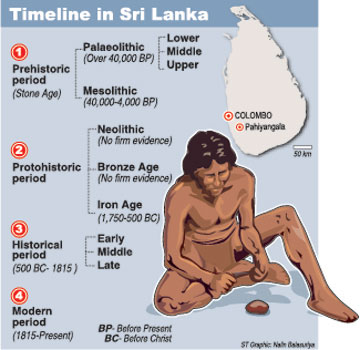
The human of Pahiyangala has left a trail leading back to a time, shrouded in layers of soil. “We will have to check whether any tools or implements have been buried with it,” says Oshan, explaining that they will also have to check whether flowers were laid by its side in a burial rite and if so the pollen put under the microscope. How did the human die so young, will be another puzzle they will try to solve.
Sri Lanka will have to hold its breath, for only time and tests will reveal the secrets of the Pahiyangala human.
What next?
The Pahiyangala human is below 30 years of age and has the anatomy of Modern Man, said a top archaeology official, explaining that while the charcoal (carbon) samples are to be sent to a laboratory in America, for radio-carbon dating within the next two weeks, major discussions are underway between the Department of Archaeology and both Oxford University and the Australian National University to launch in-depth studies by a team of local and foreign experts.
The carbon samples will be sent to Beta Analytic in Miami, said Director (Excavations), Dr. Nimal Perera, explaining that the skeleton, meanwhile, needs to undergo bio-anthropological studies.These decisions were taken after a site-visit last Tuesday by a high level team comprising DG Dr. Senarath Dissanayake, Dr. Perera and Dr. Siran Deraniyagala, the Sunday Times learns.
Earlier believed to be 12,000 years old, Dr. Deraniyagala thinks that the skeleton may be more than 36,000 years old.
The removal of the skeleton from the site has to be done with utmost care, Dr. Perera stressed, adding that follow-up studies would be under the Collaborative Research Programme.
The skeleton is on weathered rock and removal would not be easy, as it should be taken along with the deposit around it, he said.
The studies that will be undertaken will include the measurements of the skeleton as well as comparisons with not only the Veddahs of Sri Lanka but also aborigines of South Asia and Australia. The experts will also attempt to ascertain the environment in which the individual lived, the subsistence pattern and delve into palae-pathology to find out how the human died.
DNA tests will also be carried out may be with the teeth, he said pointing out that the skeleton is a good find because most of the bones uncovered earlier have been fragmentary and highly weathered.
Whether man or woman has not been determined yet and the human has also not been named yet, adds Dr. Perera.
comments powered by Disqus














